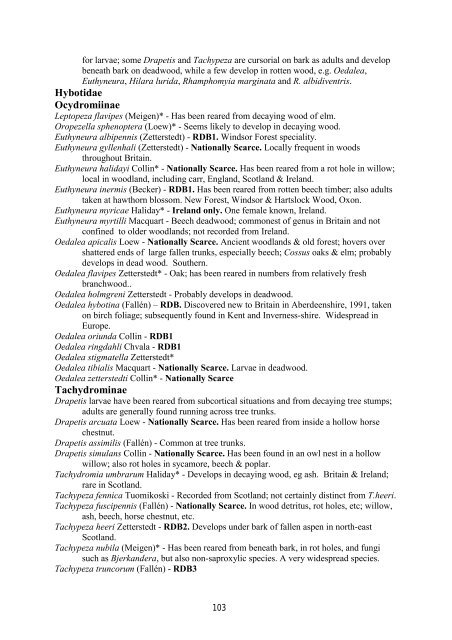Crustacea: Copepoda - Cerambycoidea.com
Crustacea: Copepoda - Cerambycoidea.com
Crustacea: Copepoda - Cerambycoidea.com
You also want an ePaper? Increase the reach of your titles
YUMPU automatically turns print PDFs into web optimized ePapers that Google loves.
for larvae; some Drapetis and Tachypeza are cursorial on bark as adults and develop<br />
beneath bark on deadwood, while a few develop in rotten wood, e.g. Oedalea,<br />
Euthyneura, Hilara lurida, Rhamphomyia marginata and R. albidiventris.<br />
Hybotidae<br />
Ocydromiinae<br />
Leptopeza flavipes (Meigen)* - Has been reared from decaying wood of elm.<br />
Oropezella sphenoptera (Loew)* - Seems likely to develop in decaying wood.<br />
Euthyneura albipennis (Zetterstedt) - RDB1. Windsor Forest speciality.<br />
Euthyneura gyllenhali (Zetterstedt) - Nationally Scarce. Locally frequent in woods<br />
throughout Britain.<br />
Euthyneura halidayi Collin* - Nationally Scarce. Has been reared from a rot hole in willow;<br />
local in woodland, including carr, England, Scotland & Ireland.<br />
Euthyneura inermis (Becker) - RDB1. Has been reared from rotten beech timber; also adults<br />
taken at hawthorn blossom. New Forest, Windsor & Hartslock Wood, Oxon.<br />
Euthyneura myricae Haliday* - Ireland only. One female known, Ireland.<br />
Euthyneura myrtilli Macquart - Beech deadwood; <strong>com</strong>monest of genus in Britain and not<br />
confined to older woodlands; not recorded from Ireland.<br />
Oedalea apicalis Loew - Nationally Scarce. Ancient woodlands & old forest; hovers over<br />
shattered ends of large fallen trunks, especially beech; Cossus oaks & elm; probably<br />
develops in dead wood. Southern.<br />
Oedalea flavipes Zetterstedt* - Oak; has been reared in numbers from relatively fresh<br />
branchwood..<br />
Oedalea holmgreni Zetterstedt - Probably develops in deadwood.<br />
Oedalea hybotina (Fallén) – RDB. Discovered new to Britain in Aberdeenshire, 1991, taken<br />
on birch foliage; subsequently found in Kent and Inverness-shire. Widespread in<br />
Europe.<br />
Oedalea oriunda Collin - RDB1<br />
Oedalea ringdahli Chvala - RDB1<br />
Oedalea stigmatella Zetterstedt*<br />
Oedalea tibialis Macquart - Nationally Scarce. Larvae in deadwood.<br />
Oedalea zetterstedti Collin* - Nationally Scarce<br />
Tachydrominae<br />
Drapetis larvae have been reared from subcortical situations and from decaying tree stumps;<br />
adults are generally found running across tree trunks.<br />
Drapetis arcuata Loew - Nationally Scarce. Has been reared from inside a hollow horse<br />
chestnut.<br />
Drapetis assimilis (Fallén) - Common at tree trunks.<br />
Drapetis simulans Collin - Nationally Scarce. Has been found in an owl nest in a hollow<br />
willow; also rot holes in sycamore, beech & poplar.<br />
Tachydromia umbrarum Haliday* - Develops in decaying wood, eg ash. Britain & Ireland;<br />
rare in Scotland.<br />
Tachypeza fennica Tuomikoski - Recorded from Scotland; not certainly distinct from T.heeri.<br />
Tachypeza fuscipennis (Fallén) - Nationally Scarce. In wood detritus, rot holes, etc; willow,<br />
ash, beech, horse chestnut, etc.<br />
Tachypeza heeri Zetterstedt - RDB2. Develops under bark of fallen aspen in north-east<br />
Scotland.<br />
Tachypeza nubila (Meigen)* - Has been reared from beneath bark, in rot holes, and fungi<br />
such as Bjerkandera, but also non-saproxylic species. A very widespread species.<br />
Tachypeza truncorum (Fallén) - RDB3<br />
103

















